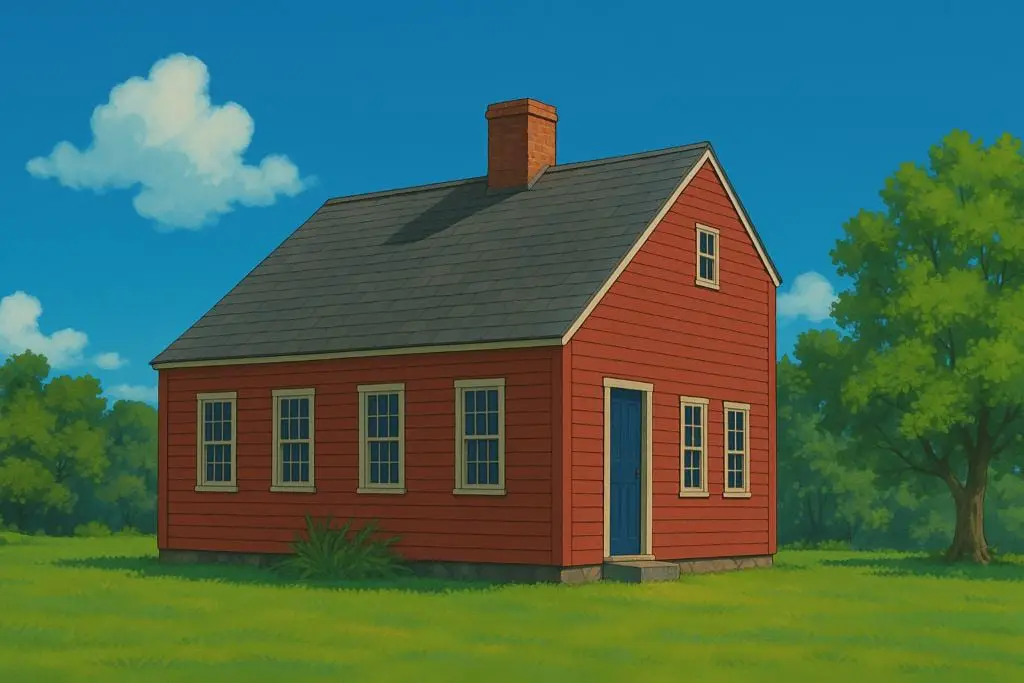I participate in the Amazon affiliate program and may earn commissions from purchases made through links on this page.
Table of Contents

Introduction
This calculator works for both saltbox roofs and asymmetrical gable roofs. These two roof types share enough geometric similarities that the same tool can calculate dimensions, surface areas, and attic volumes accurately for either type.
What Is a Saltbox Roof?
A saltbox roof is a distinctive, asymmetrical roof style where the ridge is normally offset from the center and the front and back roof planes are unequal in length. The front and back walls are different heights, resulting in two eaves at different elevations. A saltbox roof often looks like a regular gable roof that has had an additional shed roof with the same roof slope added in the back.
In many traditional saltbox designs, both sides of the roof have the same slope, but the lower wall height on one side leads to additional interior volume and a longer roof section. The slopes may also be different; it’s the combination of unequal wall heights and a typically off-center ridge that defines the saltbox.
Key features include:
- An off-center ridge line
- A shorter front roof run and a longer back run
- Eaves at different heights
- A single-story rear extension beneath the long slope
In this calculator, you define your saltbox roof by entering front and back wall heights, the distance from the front wall to the ridge, and the back slope. The calculator then derives the necessary front slope and computes all other dimensions based on these inputs.
What Is an Asymmetrical Gable Roof?
An asymmetrical gable roof is a variation on the standard gable roof in which the two sloping roof planes are different in length and slope with a ridge line offset from the center to accomodate these differences. Unlike a saltbox roof, the front and back walls are the same height, so you have a horizontally balanced base structure with an off-center roof.
This results in one side of the roof being either longer or steeper than the other. Asymmetrical gable roofs are sometimes used for stylistic variation or to optimize interior space beneath one side of the roof.
Key characteristics include:
- Equal front and back wall heights
- An offset ridge
- Unequal roof slopes
- Unequal roof section lengths and areas
To use this calculator for an asymmetrical gable roof, enter identical wall heights for the front and back.
What This Calculator Does
This saltbox roof calculator determines the key dimensional attributes of a saltbox or asymmetrical gable roof based on your inputs:
- Total roof surface area: The combined area of the two sloped roof planes, including overhangs.
- Roof footprint: The horizontal area covered by the roof, accounting for eave and gable-end overhangs.
- Attic volume: An estimate of the usable attic space formed by the sloped roof above the front wall height. The calculator models this as a triangular prism bounded by the front wall, front sloped roof, and the portion of the back sloped roof that lies above the front wall height.
- Perimeter: The total length of all roof edges, including the horizontal eaves and sloped rake edges along the gable ends.
- Total eave length: The combined length of the front and back eaves. This equals twice the adjusted roof length, including gable-end overhangs.
- Total rake edge length: The combined length of the sloped edges along both gable ends. Each gable end has two rake edges: one for the front slope and one for the back slope.
- Ridge length: The full horizontal length of the ridge where the two roof planes meet, including any gable-end overhangs.
- Ridge height: The vertical distance from the bottom of the back wall to the level of the ridge. This is calculated from the back wall height and slope input.
- Front and back roof runs: The horizontal distances from the ridge to the outside of the front and back walls.
- Front and back rises: The vertical height from the top of each wall to height of the ridge.
- Slant height: The true length of each sloped roof surface, from the eave to the ridge, including eave overhangs.
- Roof slope (X-in-12 and degrees): The pitch of each roof plane, displayed in both standard pitch and angle format.
- Pitch multiplier: The ratio of slant height to horizontal run for each slope. This is useful for estimating rafter lengths and surface area without directly using trigonometric functions. Read more about roof pitch multipliers.
How to Use It
1. Choose your measurement system
Select either USA (feet and X-in-12 roof slope) or Metric (meters and degrees). All input fields accept decimal values.
2. Enter the structural dimensions
- Building Width: The horizontal distance across the gable end of the structure, measured from the outer face of the front wall to the outer face of the back wall. This defines the total span of the roof from front to back.
- Building Length: The distance parallel to the ridge, measured from outer wall to outer wall along the long side of the building.
3. Enter wall heights and distance from front wall to the ridge
- Ridge Distance from Front Wall: The distance from the front wall to the ridge line, measured horizontally. This determines how far off-center the ridge is.
- Front Wall Height and Back Wall Height: The vertical height of each wall from the base of the structure to the top of the upper wall plate. These can be equal (for asymmetrical gable roofs) or different (for saltbox roofs).
- Make sure wall heights share the same reference level. The calculator assumes both wall heights begin at the same base elevation. If one wall sits lower (for example, more exposed foundation or a step in the footing), subtract the amount that is below the higher wall’s base before entering that wall height in the calculator. This keeps both wall heights referenced to the same level and preserves accurate roof geometry for the calculator.
4. Enter the back roof slope
- In USA mode, the slope is entered as the X value for the pitch expression “X in 12”
- In Metric mode, the slope is entered in degrees
- The calculator will automatically derive the front slope based on the ridge position and wall heights. An easy way to determine your roof slope is to use this pitch measurement tool (on Amazon). I have one (actually two, because I thought I lost the first one but I found it after I bought another one); it doesn’t cost much and it works very well.
5. Add optional overhangs
- Eave Overhang: The amount the roof extends beyond the front and back walls. You can set a different eave overhang value for the front and back. Enter in inches (USA) or millimeters (Metric).
- Gable-End Overhang: The amount the roof extends beyond the gable ends (left and right sides). The calculator assumes equal overhangs at each gable end, so just enter the overhang value for one gable end and it will be doubled for the calculations where it is used.
- These can be set to zero if your roof has no overhangs.
6. Click “Calculate”
The tool will generate detailed roof dimensions, surface areas, ridge height, attic volume, and other geometric outputs.
7. Click “Clear”
This will reset all fields and remove any error messages or results.
Saltbox and Asymmetrical Gable Roof Calculator
This is not a framing calculator. If you are looking for expert guidance on framing a roof, I recommend you get a copy of A Roof Cutter’s Secrets to Framing the Custom Home (link is to Amazon).

